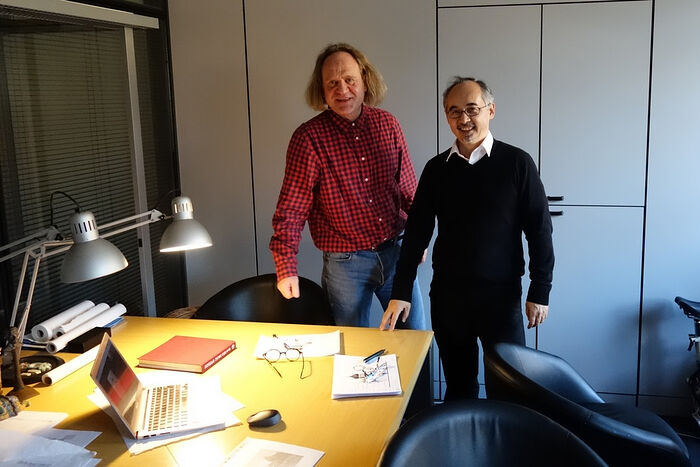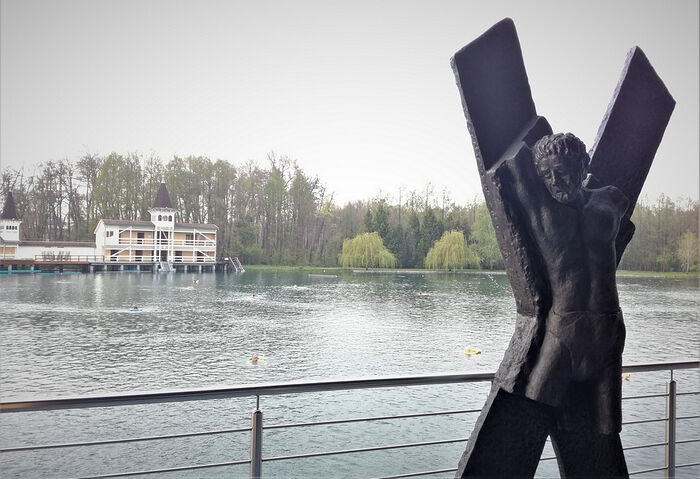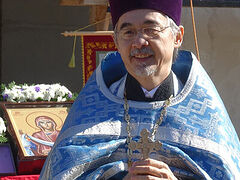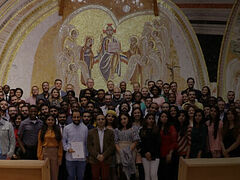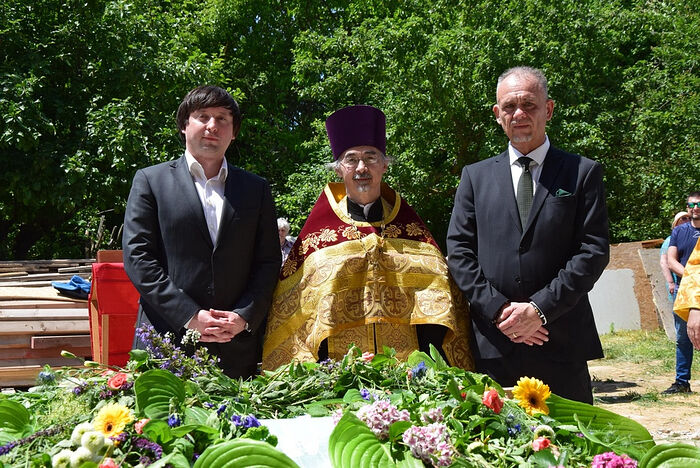 Papp Gabor, the Mayor of Heviz (right), at the ceremony of the unveiling of a cross on the Orthodox church dome
Papp Gabor, the Mayor of Heviz (right), at the ceremony of the unveiling of a cross on the Orthodox church dome
—Now let’s talk about your parish. First, about its history. How did the idea of building a church here come about? Who came up with this initiative?
—To begin with, the founders of resort churches in Austria-Hungary were rectors of the Imperial Church of the Holy Martyr Empress Alexandra in Üröm; in Karlovy Vary these were Archpriests Vasily Voitkovsky and Konstantin Kustodiev, in Merano and Mariánské Lázně —Archpriest Theophilus Kardasevich. In the nineteenth century the initiators and church builders were representatives of the ruling dynasty or members of other noble families.
Heviz is an all-season resort. In recent years, many Russian-speaking guests would come here for the winter holidays, and they expressed the desire to celebrate the Nativity of Chris in an Orthodox church. The director of the Hungarian Robinson Tours travel agency Mr. György Jakócs appealed to the Diocese of Hungary, and in 2011 Orthodox Nativity services were held in the Catholic church of Heviz by Priest Kirill Tatarka. During those years, there was a real boom in the purchase of real estate by Russian-speaking guests in Heviz and its outskirts, and then it seemed that building a church for a rapidly growing community was a feasible task. The initiative of establishing a parish in Heviz belonged to several Russian-speaking families living in this area. We should specially mention the large Chepyzhov family (Vladimir and Tatyana and their five children are all church-goers, and Vladimir later became a deacon). Many other local Orthodox enthusiastically supported this initiative, but it soon became clear that a pious desire to have a church was not enough—serious financial investments were needed, which were too much for the emigrants. Nevertheless, the community’s request was heard by our Church hierarchy and by the decision of the Holy Synod of October 4, 2012 (the twentieth anniversary of my ordination to the priesthood), as an employee of the Department for External Church Relations I was sent to the Diocese of Hungary with the assignment of organizing a new parish and regularizing liturgical life. At the very first meeting in December 2012, the mayor, whose constituent assembly was held on November 1, noted that in such a small town there were already five Christian churches. He himself was an active member of the Protestant community. Over the years, cooperation with the mayor’s office has become a stable, kind and mutually respectful relationship. In his welcoming speech on June 10, 2021, at the unveiling ceremony for the Orthodox cross on the dome, the Mayor of Heviz Mr. Papp Gabor called the church that was under construction the town’s “new gem”, stressing that the cross on the building clearly showed that this was a House of God. The church will be consecrated in honor of the “Life-Giving Spring” Icon of the Mother of God; the parish icon of this type was painted by iconographer Tatiana Puzanova-Galach in 2014.
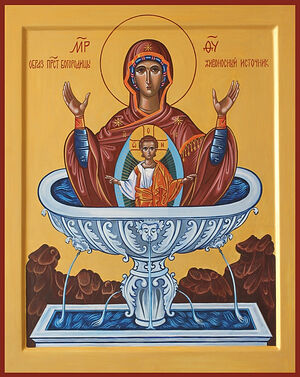 The Parish Icon of the “Life-Giving Spring” The architectural design of the church was prepared by a talented Hungarian architect and winner of the IBLA Grand Prize Competition, Mr. Laszlo Vancza. He took on the assignment very reverently and responsibly. This has become a precedent in Hungarian architectural history, because earlier when Orthodox churches were built there, they had to look at least on the exterior like Catholic churches. The designer first of all studied all the literature on Russian church architecture available in Hungarian. Wishing to combine ancient Russian motifs with modern stylistic solutions in the design, he chose a masterpiece to base it on—the St. George Cathedral of the St. George (“Yuryev”) Monastery in Veliky Novgorod. After the presentation of the first draft of the design, there was a detailed discussion with a leading specialist on architecture from the Moscow Patriarchal Commission—Archpriest Andrei Yurevich. As the result of joint creative work, the final design of the church was completed, and was received full approval by both ordinary worshippers and specialists, among whom was Golda Janos from the Hungarian Academy of Arts.
The Parish Icon of the “Life-Giving Spring” The architectural design of the church was prepared by a talented Hungarian architect and winner of the IBLA Grand Prize Competition, Mr. Laszlo Vancza. He took on the assignment very reverently and responsibly. This has become a precedent in Hungarian architectural history, because earlier when Orthodox churches were built there, they had to look at least on the exterior like Catholic churches. The designer first of all studied all the literature on Russian church architecture available in Hungarian. Wishing to combine ancient Russian motifs with modern stylistic solutions in the design, he chose a masterpiece to base it on—the St. George Cathedral of the St. George (“Yuryev”) Monastery in Veliky Novgorod. After the presentation of the first draft of the design, there was a detailed discussion with a leading specialist on architecture from the Moscow Patriarchal Commission—Archpriest Andrei Yurevich. As the result of joint creative work, the final design of the church was completed, and was received full approval by both ordinary worshippers and specialists, among whom was Golda Janos from the Hungarian Academy of Arts.
The construction of the church had begun before emergency situation brought on by the coronavirus in March 2020. But in the following months, construction work didn’t stop for a single day thanks to the conscientious and pious builders from Moldova. We thank God for sending us Orthodox workers from the Odessa Construction company headed by director Valentin Sirbu and foreman Nikolai Brega. The church walls of white stone have already been erected, a dome and a cross installed, and the finishing and roofing work is in progress.
—Is the community large today? Does it consist of Russians, or are there representatives of other nationalities, including locals?
—The specific character of the ministry at a spa town implies that guests from all over the globe become members of your parish for a time, and openness has to be the main attribute of the community and its permanent members. Currently, a team of builders from Moldova are our parishioners—too: they keep a perpetually-burning icon lamp in the altar of the church under construction, make the construction site ready for services, confess and receive Communion. Over the years Heviz has become a little “Russian”, and I wouldn’t be able to mention all the helpers by name. The parish, of course, relies on locals—substantial help is provided by people long settled in Hungary. For example, the Parish Council Secretary Elena Peters—a native of Donetsk, a linguist, poet, and artist without whom not a single working meeting is held... Natalia and Maria Prokk are long-term singers of our parish choir. In addition to our compatriots, some native Hungarians joined the community—for instance, the parish deacon Stefan Vaino-Eliasz and his wife Marta, who conducts the choir in which their daughters sing. Several more Hungarian parishioners regularly attend our services and help in parish affairs—thanks to them our parish website has a Hungarian version, which is very important since not only parishioners, but also municipal authorities and the media can easily learn all the news and plans of our Orthodox parish.
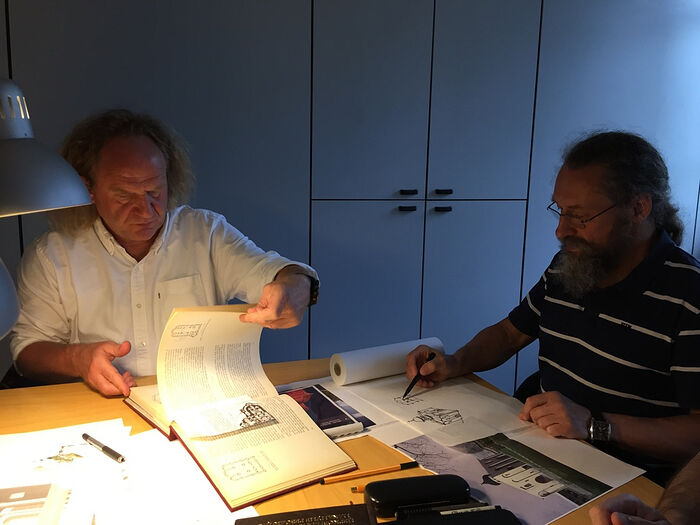 The Architects Laszlo Vancza and Fr. Andrei Yurevich
The Architects Laszlo Vancza and Fr. Andrei Yurevich
The rector is Korean, the secretary is Russian, and the deacon is Hungarian—so, to say that the parish in Heviz is multinational is to say nothing. Romanians, Serbs, Greeks, Poles, and, of course, Russian-speaking people from across the globe come to pray here.
—Are there any patterns observable in the behavior of Russians who have moved here from Russia and other parts of the “Russian World”, and then become parishioners?
—In the past days of globalization, resettlement wasn’t considered something special or well-considered. It would seem convenient and prestigious to have real estate abroad, but the pandemic made people feel all the unforeseen difficulties of such a decision because in Hungary, buying real estate gives no advantage to the buyer for permanent residence, and getting a visa is often difficult. During the lockdowns, crossing the borders turned out to be difficult, and for many there has been simply no opportunity to travel to visit their relatives or, conversely, visit their properties. However, in my contact with people I see that each has his own destiny and reason to travel to or live in Hungary, and the general patterns will probably be revealed by sociologists over time. Mixed marriages are fairly common, and it is gratifying that in such families many children get baptized in Orthodoxy. In Hungary Orthodoxy is recognized as a traditional religion and is supported by the State; there is no discrimination against adherents of the Orthodox faith.
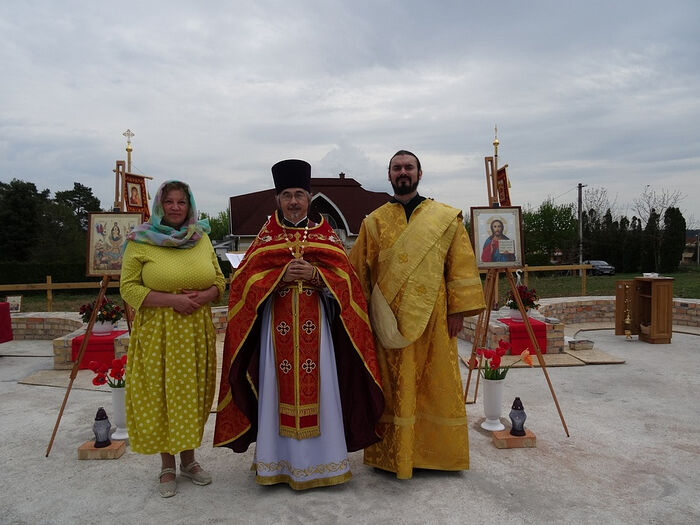 With Deacon Stefan Vaino-Eliasz and the Parish Council Secretary Elena Peters. Pascha 2020
With Deacon Stefan Vaino-Eliasz and the Parish Council Secretary Elena Peters. Pascha 2020
—What are the most striking cases of local people converting to Orthodoxy?
—Interest in Orthodoxy often appears thanks to the knowledge that it is closest to the origins of Christianity. In the eighteenth century, the Habsburg Empire propagated Catholicism aggressively, fighting the Protestants, calling them (and Orthodox) schismatics. But the constancy and continuity of the Orthodox teaching, based on the Holy Fathers and the Ecumenical Councils, proves that it didn’t fall away from the early Church, and today in Hungary young people are joining the Orthodox Church with this knowledge. This year, two young Hungarians have joined our parish, each in his own way. As students of a Catholic school they thoroughly studied the history of Christianity and came to the conclusion that it was in Orthodoxy that the unchanged Christian doctrine has been preserved. They began attending our services; one of them converted to Orthodoxy with his parents’ consent, and the other is still preparing for this step, but is already learning our hymns because he wants to sing in the choir. Hungarians show great interest in the modern presentation of Orthodox teaching—for example, former abbot of the Benedictine monastery at Tihany Richard Korzetsky translates the writings of Sts. Ignatius (Brianchaninov) and Theophan the Recluse into Hungarian; these books were published by the abbey’s publishing house. There are other publishing houses that translate and publish Orthodox literature.
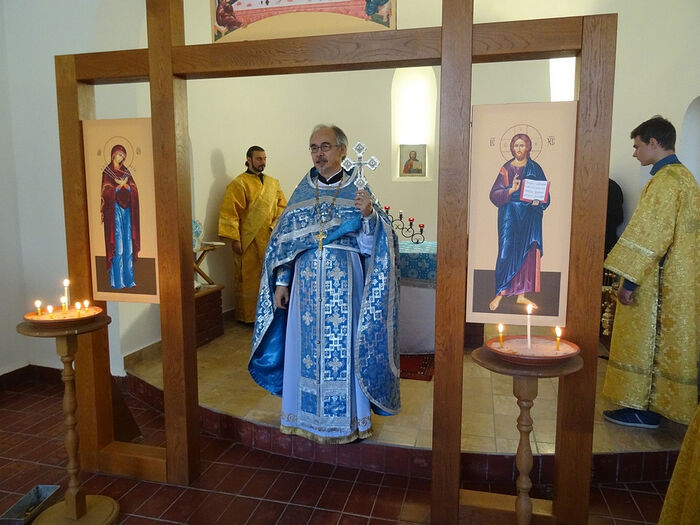 The Iconostasis at St. Stephen’s Church in Zalavar
The Iconostasis at St. Stephen’s Church in Zalavar
—In what language do you celebrate services? Are there any distinctive characteristics in the parish traditions and the life of the community? Do you especially venerate some saints?
—The peculiarities have to do with the fact that until recently the parish didn’t have its own building, and we worshipped in Catholic churches. We would bring a portable collapsible altar table, an iconostasis and candlesticks—all of this was installed in a particular church, a service was held, then everything was disassembled and taken away. Of course, these were rather unusual and hard conditions, but we have visited different cities, met many people, and now we can say with confidence that our community unites the faithful not only in Heviz and the surroundings, but throughout Western Hungary.
Of course, most services are celebrated in Church Slavonic, but given the multinational nature of our parish, some litanies are pronounced in Hungarian, and certain hymns are sung in that language. The Scriptures are read in two languages, and “Our Father” is repeated by the whole congregation in Hungarian after Slavonic. When the builders from Moldova joined our parish, we introduced some Moldovan elements into the services.
Our patronal feast is that of the “Life-Giving Spring” Icon (May 7). In addition, we honor the memory of the heavenly patrons of the country and area. They are Hungarian: Holy King Istvan (Stephen), Holy Martyr George the Hungarian who suffered with Holy Passion-Bearer Prince Boris, and his brothers, Venerable Moses the Hungarian and Ephraim of New Torzhok. We also venerate Equal-to-the-Apostles Cyril and Methodius (they prayed and preached in these places), and the Holy Apostle Andrew the First-Called (he was considered the patron-saint of Heviz many centuries ago). St. Martin of Tours was born in the western part of the Roman province of Pannonia, so he is a heavenly patron of Hungary as well.
—To what extent are the parishioners involved in community life? Do such duties as beautifying the church site and financial issues lie entirely on the priest’s shoulders, or do the most active parishioners share the burden of the priest? Can we say that the parish council and assembly are “alive”?
—The parish is in the process of formation. We spent the first decade wandering. In these difficult conditions people emerged who had fervent faith, who sincerely love prayer and the services and thirst for the Word of God. There are not so many of them, which is the case anywhere, but they are the heart of the community; the priest can rely on their support, they are the spiritual “stones” that make up the parish foundation. I remember with gratitude the faithful parishioners not only from Heviz and the surrounding area, but also from other cities further away—Kaposvar and Budapest. Fortunately, all the active parishioners are members of the parish assembly and council. We can say that these parish management bodies are real and “alive”, as you put it.
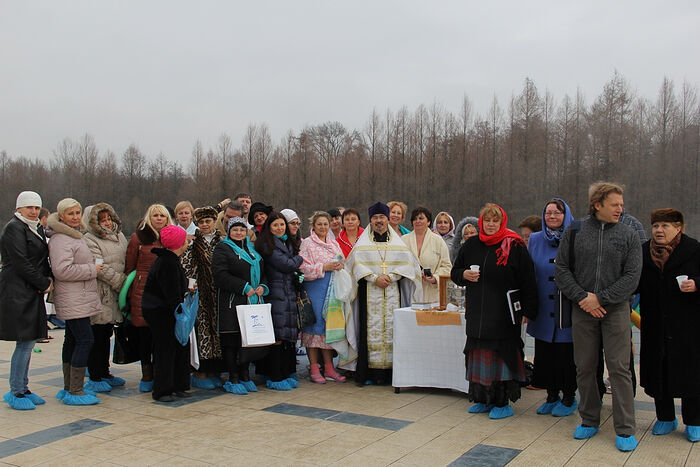 The Blessing of the Waters on the Theophany on lake Heviz
The Blessing of the Waters on the Theophany on lake Heviz
Although the majority of people who come to church are well-disposed towards the faith and the Church, many observe the fasts, prepare for confession and Communion, it is difficult to call them active members of the community. Now the church construction is underway; on the parish website and the parish Facebook page you can see weekly photo reports and a description of the work done to date. On the one hand, it may be good that by their “likes” people feel like participants in this good cause. But, on the other hand, one needs to understand that we too carried away by the virtualization of life; so may God grant that the hierarchy of spiritual values be preserved in the minds of Orthodox users and they won’t put Orthodox parish news on the same level as cats and salads.
—Do you manage to conduct any educational, charitable or social projects?
—Now the primary task for the parish is to complete the construction of the church. But at the same time, we do social, educational, cultural and missionary work. For the major holidays the parish prepares gifts and greetings for residents of nursing homes in Heviz and we also collect clothes and distribute them to low-income families. Since the first years we have had a parish school for children and adults. We teach in two languages—Russian and Hungarian. Along with doctrinal subjects (catechism, Bible study and liturgics), we have many creative lessons—music, drawing and needlework—because talents (gifts of God) manifest themselves in any creative work. As a rule, classes are held by the Parish Council Secretary Elena Peters (in Russian) and Deacon Stefan Vaino-Eliasz (in Hungarian), but other teachers are gradually joining them.
—Tell us about the most remarkable events in the parish life in its short history.
—All events pale next to the raising of an Orthodox cross on top of a church under construction in the heart of Europe. Though a mere resort and one of many on earth, it’s worth remembering that it was here that the future Roman Emperor Theodosius the Great (who summoned the Second Ecumenical Council) was cured of polio in childhood. Not far from here, in the capital of the Principality of Blaten, Sts. Cyril and Methodius preached. Heviz itself used to bear the name of Apostle Andrew the First-Called, and a sculpture of his crucifixion can be seen in a bathing house on the lake. In a suburb of Heviz, on Egregy Hill, there is an ancient church of the era of the Arpad Dynasty, and we hope with boldness that the new Orthodox church in Heviz will be ranked among the local holy places through the prayers and good deeds of its parishioners.

